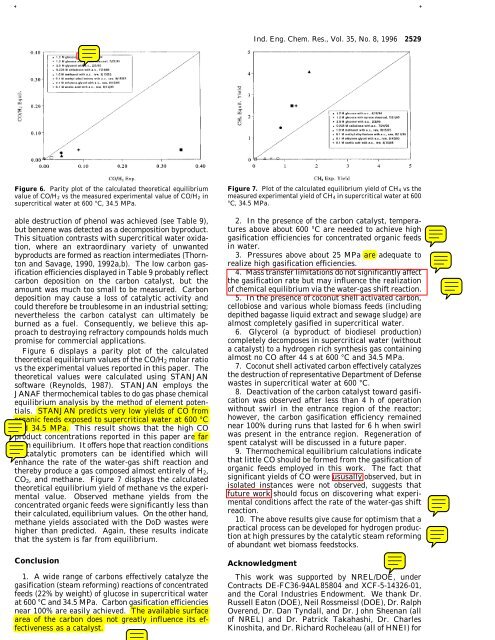Carbon-Catalyzed Gasification of Organic Feedstocks in ...
Carbon-Catalyzed Gasification of Organic Feedstocks in ...
Carbon-Catalyzed Gasification of Organic Feedstocks in ...
You also want an ePaper? Increase the reach of your titles
YUMPU automatically turns print PDFs into web optimized ePapers that Google loves.
+ +<br />
Ind. Eng. Chem. Res., Vol. 35, No. 8, 1996 2529<br />
Figure 6. Parity plot <strong>of</strong> the calculated theoretical equilibrium<br />
value <strong>of</strong> CO/H 2 vs the measured experimental value <strong>of</strong> CO/H 2 <strong>in</strong><br />
supercritical water at 600 °C, 34.5 MPa.<br />
able destruction <strong>of</strong> phenol was achieved (see Table 9),<br />
but benzene was detected as a decomposition byproduct.<br />
This situation contrasts with supercritical water oxidation,<br />
where an extraord<strong>in</strong>ary variety <strong>of</strong> unwanted<br />
byproducts are formed as reaction <strong>in</strong>termediates (Thornton<br />
and Savage, 1990, 1992a,b). The low carbon gasification<br />
efficiencies displayed <strong>in</strong> Table 9 probably reflect<br />
carbon deposition on the carbon catalyst, but the<br />
amount was much too small to be measured. <strong>Carbon</strong><br />
deposition may cause a loss <strong>of</strong> catalytic activity and<br />
could therefore be troublesome <strong>in</strong> an <strong>in</strong>dustrial sett<strong>in</strong>g;<br />
nevertheless the carbon catalyst can ultimately be<br />
burned as a fuel. Consequently, we believe this approach<br />
to destroy<strong>in</strong>g refractory compounds holds much<br />
promise for commercial applications.<br />
Figure 6 displays a parity plot <strong>of</strong> the calculated<br />
theoretical equilibrium values <strong>of</strong> the CO/H 2 molar ratio<br />
vs the experimental values reported <strong>in</strong> this paper. The<br />
theoretical values were calculated us<strong>in</strong>g STANJAN<br />
s<strong>of</strong>tware (Reynolds, 1987). STANJAN employs the<br />
JANAF thermochemical tables to do gas phase chemical<br />
equilibrium analysis by the method <strong>of</strong> element potentials.<br />
STANJAN predicts very low yields <strong>of</strong> CO from<br />
organic feeds exposed to supercritical water at 600 °C<br />
and 34.5 MPa. This result shows that the high CO<br />
product concentrations reported <strong>in</strong> this paper are far<br />
from equilibrium. It <strong>of</strong>fers hope that reaction conditions<br />
or catalytic promoters can be identified which will<br />
enhance the rate <strong>of</strong> the water-gas shift reaction and<br />
thereby produce a gas composed almost entirely <strong>of</strong> H 2 ,<br />
CO 2 , and methane. Figure 7 displays the calculated<br />
theoretical equilibrium yield <strong>of</strong> methane vs the experimental<br />
value. Observed methane yields from the<br />
concentrated organic feeds were significantly less than<br />
their calculated, equilibrium values. On the other hand,<br />
methane yields associated with the DoD wastes were<br />
higher than predicted. Aga<strong>in</strong>, these results <strong>in</strong>dicate<br />
that the system is far from equilibrium.<br />
Conclusion<br />
1. A wide range <strong>of</strong> carbons effectively catalyze the<br />
gasification (steam reform<strong>in</strong>g) reactions <strong>of</strong> concentrated<br />
feeds (22% by weight) <strong>of</strong> glucose <strong>in</strong> supercritical water<br />
at 600 °C and 34.5 MPa. <strong>Carbon</strong> gasification efficiencies<br />
near 100% are easily achieved. The available surface<br />
area <strong>of</strong> the carbon does not greatly <strong>in</strong>fluence its effectiveness<br />
as a catalyst.<br />
Figure 7. Plot <strong>of</strong> the calculated equilibrium yield <strong>of</strong> CH 4 vs the<br />
measured experimental yield <strong>of</strong> CH 4 <strong>in</strong> supercritical water at 600<br />
°C, 34.5 MPa.<br />
2. In the presence <strong>of</strong> the carbon catalyst, temperatures<br />
above about 600 °C are needed to achieve high<br />
gasification efficiencies for concentrated organic feeds<br />
<strong>in</strong> water.<br />
3. Pressures above about 25 MPa are adequate to<br />
realize high gasification efficiencies.<br />
4. Mass transfer limitations do not significantly affect<br />
the gasification rate but may <strong>in</strong>fluence the realization<br />
<strong>of</strong> chemical equilibrium via the water-gas shift reaction.<br />
5. In the presence <strong>of</strong> coconut shell activated carbon,<br />
cellobiose and various whole biomass feeds (<strong>in</strong>clud<strong>in</strong>g<br />
depithed bagasse liquid extract and sewage sludge) are<br />
almost completely gasified <strong>in</strong> supercritical water.<br />
6. Glycerol (a byproduct <strong>of</strong> biodiesel production)<br />
completely decomposes <strong>in</strong> supercritical water (without<br />
a catalyst) to a hydrogen rich synthesis gas conta<strong>in</strong><strong>in</strong>g<br />
almost no CO after 44 s at 600 °C and 34.5 MPa.<br />
7. Coconut shell activated carbon effectively catalyzes<br />
the destruction <strong>of</strong> representative Department <strong>of</strong> Defense<br />
wastes <strong>in</strong> supercritical water at 600 °C.<br />
8. Deactivation <strong>of</strong> the carbon catalyst toward gasification<br />
was observed after less than 4h<strong>of</strong>operation<br />
without swirl <strong>in</strong> the entrance region <strong>of</strong> the reactor;<br />
however, the carbon gasification efficiency rema<strong>in</strong>ed<br />
near 100% dur<strong>in</strong>g runs that lasted for 6 h when swirl<br />
was present <strong>in</strong> the entrance region. Regeneration <strong>of</strong><br />
spent catalyst will be discussed <strong>in</strong> a future paper.<br />
9. Thermochemical equilibrium calculations <strong>in</strong>dicate<br />
that little CO should be formed from the gasification <strong>of</strong><br />
organic feeds employed <strong>in</strong> this work. The fact that<br />
significant yields <strong>of</strong> CO were ususally observed, but <strong>in</strong><br />
isolated <strong>in</strong>stances were not observed, suggests that<br />
future work should focus on discover<strong>in</strong>g what experimental<br />
conditions affect the rate <strong>of</strong> the water-gas shift<br />
reaction.<br />
10. The above results give cause for optimism that a<br />
practical process can be developed for hydrogen production<br />
at high pressures by the catalytic steam reform<strong>in</strong>g<br />
<strong>of</strong> abundant wet biomass feedstocks.<br />
Acknowledgment<br />
This work was supported by NREL/DOE, under<br />
Contracts DE-FC36-94AL85804 and XCF-5-14326-01,<br />
and the Coral Industries Endowment. We thank Dr.<br />
Russell Eaton (DOE), Neil Rossmeissl (DOE), Dr. Ralph<br />
Overend, Dr. Dan Tyndall, and Dr. John Sheenan (all<br />
<strong>of</strong> NREL) and Dr. Patrick Takahashi, Dr. Charles<br />
K<strong>in</strong>oshita, and Dr. Richard Rocheleau (all <strong>of</strong> HNEI) for
















